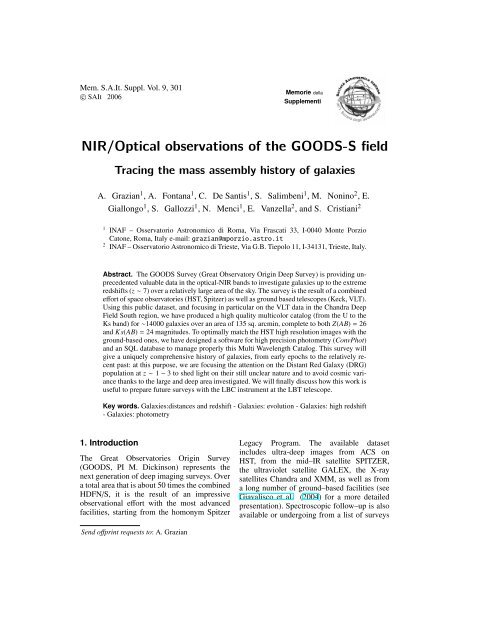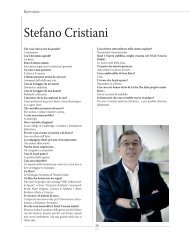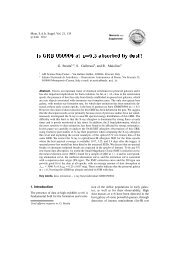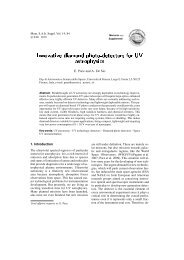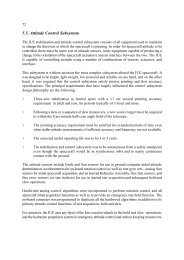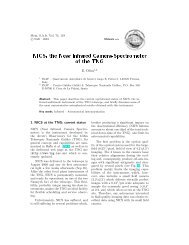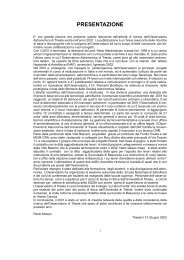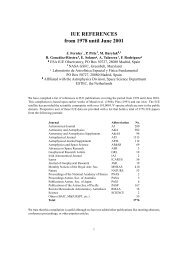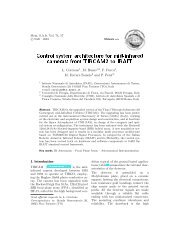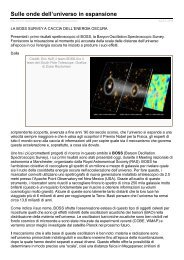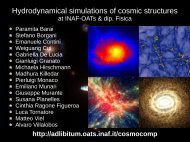PDF file - Memorie della SAIt
PDF file - Memorie della SAIt
PDF file - Memorie della SAIt
Create successful ePaper yourself
Turn your PDF publications into a flip-book with our unique Google optimized e-Paper software.
Mem. S.A.It. Suppl. Vol. 9, 301<br />
c○ <strong>SAIt</strong> 2006<br />
<strong>Memorie</strong> <strong>della</strong><br />
Supplementi<br />
NIR/Optical observations of the GOODS-S field<br />
Tracing the mass assembly history of galaxies<br />
A. Grazian 1 , A. Fontana 1 , C. De Santis 1 , S. Salimbeni 1 , M. Nonino 2 , E.<br />
Giallongo 1 , S. Gallozzi 1 , N. Menci 1 , E. Vanzella 2 , and S. Cristiani 2<br />
1 INAF – Osservatorio Astronomico di Roma, Via Frascati 33, I-0040 Monte Porzio<br />
Catone, Roma, Italy e-mail: grazian@mporzio.astro.it<br />
2 INAF – Osservatorio Astronomico di Trieste, Via G.B. Tiepolo 11, I-34131, Trieste, Italy.<br />
Abstract. The GOODS Survey (Great Observatory Origin Deep Survey) is providing unprecedented<br />
valuable data in the optical-NIR bands to investigate galaxies up to the extreme<br />
redshifts (z ∼ 7) over a relatively large area of the sky. The survey is the result of a combined<br />
effort of space observatories (HST, Spitzer) as well as ground based telescopes (Keck, VLT).<br />
Using this public dataset, and focusing in particular on the VLT data in the Chandra Deep<br />
Field South region, we have produced a high quality multicolor catalog (from the U to the<br />
Ks band) for ∼14000 galaxies over an area of 135 sq. arcmin, complete to both Z(AB) = 26<br />
and Ks(AB) = 24 magnitudes. To optimally match the HST high resolution images with the<br />
ground-based ones, we have designed a software for high precision photometry (ConvPhot)<br />
and an SQL database to manage properly this Multi Wavelength Catalog. This survey will<br />
give a uniquely comprehensive history of galaxies, from early epochs to the relatively recent<br />
past: at this purpose, we are focusing the attention on the Distant Red Galaxy (DRG)<br />
population at z ∼ 1 − 3 to shed light on their still unclear nature and to avoid cosmic variance<br />
thanks to the large and deep area investigated. We will finally discuss how this work is<br />
useful to prepare future surveys with the LBC instrument at the LBT telescope.<br />
Key words. Galaxies:distances and redshift - Galaxies: evolution - Galaxies: high redshift<br />
- Galaxies: photometry<br />
1. Introduction<br />
The Great Observatories Origin Survey<br />
(GOODS, PI M. Dickinson) represents the<br />
next generation of deep imaging surveys. Over<br />
a total area that is about 50 times the combined<br />
HDFN/S, it is the result of an impressive<br />
observational effort with the most advanced<br />
facilities, starting from the homonym Spitzer<br />
Legacy Program. The available dataset<br />
includes ultra-deep images from ACS on<br />
HST, from the mid–IR satellite SPITZER,<br />
the ultraviolet satellite GALEX, the X-ray<br />
satellites Chandra and XMM, as well as from<br />
a long number of ground–based facilities (see<br />
Giavalisco et al. (2004) for a more detailed<br />
presentation). Spectroscopic follow–up is also<br />
available or undergoing from a list of surveys<br />
Send offprint requests to: A. Grazian
302 Grazian et al: Galaxies in GOODS-South<br />
and facilities (Cowie et al. 2004; Mignoli et al.<br />
2005; Vanzella et al. 2005).<br />
A high-quality Multi-wavelength catalog<br />
(MWC) has been produced using this public<br />
dataset at the Astronomical Observatory of<br />
Rome (AOR), on the basis of our previous experience<br />
developed within K20 and HDFS surveys.<br />
The scientific motivations are manifold:<br />
first of all, the wide spatial and spectral coverage<br />
of the GOODS field ensures an ideal<br />
dataset to study the formation and evolution<br />
of galaxies through the analysis of Luminosity,<br />
Mass functions and clustering properties till<br />
the highest available redshifts (z ∼ 7). With<br />
the Spitzer data in the MIR, indeed, it is possible<br />
to investigate the rest frame K-band till<br />
z ∼ 3, which allows to derive precisely the<br />
stellar mass in galaxies. The GOODS survey<br />
is fundamental to understand the role of stars<br />
and AGN in the energetic output of galaxies.<br />
The large volume sampled is useful to lower<br />
down biases due to cosmic variance, but still<br />
not sufficient to eliminate them totally.<br />
Not least, the GOODS data represent an<br />
innovative challenge for detailed data analysis,<br />
due to the large amount and complexity<br />
of the imaging dataset. We have dedicated a<br />
combined effort for software developing and<br />
scientific analysis applied to a public dataset,<br />
with the aim to build an important expertise<br />
in the field of multi wavelength imaging surveys.<br />
GOODS is the prototype of future wide<br />
and deep surveys: it is an ideal dataset to test<br />
smart software tools dealing with data coming<br />
from different telescopes and of very dishomogeneous<br />
quality.<br />
2. The Data<br />
The GOODS southern pointing, located over<br />
the Chandra Deep Field South and encompassing<br />
the ACS Ultra Deep Field and the GMASS<br />
ESO Large Program (Galaxy Mass Assembly<br />
ultra-deep Spectroscopic Survey, PI Cimatti),<br />
has been the target of extensive observations<br />
with ESO telescopes, carried on in the spirit<br />
of public surveys. To date, the major effort has<br />
been devoted to deep imaging observations in<br />
the J, H and Ks bands with the VLT-ISAAC<br />
infrared imager. The final area covered by the<br />
Fig. 1. The ACS GOODS-S field with the ISAAC<br />
tiling made by ESO to cover in J and Ks the whole<br />
field. The cyan square marks the position of the<br />
ACS UDF. The red rectangle marks the position of<br />
the K20 survey. The four white quadrants show the<br />
actual coverage of VLT-VIMOS U band imaging;<br />
large gaps are visible, since the observing program<br />
is just started.<br />
Ks images approaches 135 arcmin 2 to a 1σ<br />
limiting depth of typically 25-26 mag/arcmin 2<br />
(AB), making it an unique combination of<br />
depth and size in the near–IR. We have included<br />
in our analysis the b, v, i and z ACS<br />
images, the Spitzer data provided by IRAC instrument<br />
(3.6, 4.5, 5.8 and 8.0 µm) and publicly<br />
available U–band data from the 2.2ESO<br />
(U 35 and U 38 ) and VLT-VIMOS (U VIMOS ), as<br />
shown in Fig. 1. The complexity of these data<br />
is not trivial: the magnitude limits, the pixel<br />
size and the resolution of the various images<br />
are heterogeneous, going from 24 to 30 mag,<br />
from 0.03 to 0.6 arcsec/px and from 0.1 to 2.0<br />
arcsec, respectively. Indeed the ISAAC imaging<br />
has a different seeing from tile to tile, a further<br />
complication for the detailed photometric<br />
analysis of these data.<br />
Objects in the GOODS field have been detected<br />
in the z-band with the SExtractor soft-
Grazian et al: Galaxies in GOODS-South 303<br />
ware. Detailed analysis of the complex RMS<br />
pattern of the detection image, together with<br />
simulations of synthetic galaxies of different<br />
size (half light radii) and magnitude, indicates<br />
that the completeness limit at 10σ is z = 26.2<br />
(AB) in the deeper part of the image. The shallower<br />
area is complete down to z = 25.7. A<br />
more detailed analysis of the completeness and<br />
coverage of the GOODS-South is provided in<br />
Grazian et al. (2005).<br />
To estimate galaxy colors of detected objects<br />
one needs to distinguish different situations:<br />
– For b, v and i bands of ACS, where<br />
the PSF is similar to that of z band, we<br />
used SExtractor in dual image mode and<br />
MAG BES T estimator.<br />
– For J, H and Ks bands of ISAAC we<br />
used the ConvPhot software (De Santis et<br />
al. 2005), a pro<strong>file</strong> matching algorithm for<br />
precision photometry written at this purpose.<br />
We used the z band as model image<br />
and derived the photometry in each ISAAC<br />
field with the appropriate PSF pro<strong>file</strong>.<br />
– For the U 35 , U 38 and U VIMOS bands, we<br />
used ConvPhot with the b band as model<br />
image to minimize changing of galaxy<br />
morphology with wavelength.<br />
– For IRAC bands (from 3.6 to 8µm) we used<br />
ConvPhot with the z band as model image.<br />
There are two important caveats: the PSF<br />
variation across the large field and different<br />
morphologies between z and IRAC bands.<br />
A precise description of the ConvPhot software<br />
can be found in a paper by De Santis et al<br />
in this proceeding.<br />
The ConvPhot algorithm allows also to<br />
produce a residual image after the fitting procedure,<br />
which can be used to detect peculiar<br />
objects which are bright in the Ks band but<br />
too faint in the z band to avoid the selection in<br />
the optical catalog. We have complemented the<br />
GOODS z-selected catalog with ∼200 objects<br />
in the Ks band complete down to Ks = 23.8<br />
(AB) and derived the photometry of these “zdrop”<br />
galaxies in all the 14 available bands.<br />
2.1. The multi wavelength catalog<br />
From this dataset we have obtained both a z–<br />
selected as well as a K–selected sample, with ∼<br />
14000 galaxies with uniform photometry from<br />
the U to 8.0µm bands. We have designed a<br />
Web interface to manage properly the GOODS<br />
catalog as an SQL database: the MWC Web<br />
Interface is described in a paper by De Santis<br />
et al in this proceeding.<br />
2.2. Spectroscopic and Photometric<br />
redshifts<br />
We collect all the available spectroscopic informations<br />
in the GOODS South field (a large<br />
spectroscopic follow-up is currently underway<br />
with the FORS and VIMOS instruments at the<br />
VLT telescopes) and cross-correlate the spectroscopic<br />
redshifts with our photometric catalog.<br />
For the unobserved fraction of the objects,<br />
we apply our photometric redshift code<br />
to obtain well calibrated photometric redshifts,<br />
which are described on a forthcoming paper<br />
Grazian et al. (2005).<br />
There are 900 known spectroscopic redshifts<br />
of high quality in the GOODS field, less<br />
than 10% of the total catalog. We have used<br />
these galaxies to check the validity of our photometric<br />
redshift recipe and found an accuracy<br />
of σ z = 0.07. The photometric redshift code<br />
derives also the rest frame colors fitting the observed<br />
SED.<br />
3. Application of the GOODS Catalog:<br />
the Distant Red Galaxies<br />
The first application of the MWC for the<br />
GOODS field is the selection and study of<br />
the so-called DRGs, with the aim of finding<br />
early/evolved galaxies at redshift around 2-<br />
3. DRGs are important because they represent<br />
the most massive objects in the primordial<br />
Universe and it is difficult to reproduce them<br />
in current simulations (Somerville et al. 2004;<br />
Springel et al. 2005; Menci et al. 2004). Franx<br />
et al. (2003) have used the HDFS optical and<br />
NIR data to select DRGs with the color criterion<br />
J − Ks ≥ 1.3(AB), which turns out to be<br />
effective in isolating red galaxies at z ≥ 2 (the
304 Grazian et al: Galaxies in GOODS-South<br />
3<br />
2<br />
1<br />
normalization is higher than that observed in<br />
the HDFS by Franx et al. (2003). The spatial<br />
distribution of DRGs, with a clustering scale<br />
comparable to the HDF size is the main responsible<br />
of the different observed densities.<br />
Cosmic variance plays a major role in deep<br />
pencil beam surveys like HDFs or UDF, but it<br />
is still present in the GOODS data, as demonstrated<br />
in the mass function results of Fontana<br />
et al. (2005).<br />
0<br />
-1 -0.5 0 0.5 1<br />
Fig. 2. The J − Ks color compared with the U − V<br />
rest frame that is useful to select the intrinsically red<br />
population in the GOODS-South region. The Franx<br />
et al. (2003) criterion selects both intrinsically blue<br />
and red objects, stressing the dichotomy of the nature<br />
of this class.<br />
Balmer break at 4000 Å is redshifted between<br />
J and Ks at this redshift). They found 14 DRGs<br />
in an area of 5 sq. arcmin. In the GOODS field<br />
we have found 179 DRGs in an area of 135 sq.<br />
arcmin., an ideal sample to discern the nature<br />
of these galaxies.<br />
The selection proposed by Franx et al.<br />
(2003), however, is not optimal, in the sense<br />
that a single color criterion will hardly isolate a<br />
well defined class of objects at relatively high<br />
redshifts. Contaminants at z ≤ 1 are selected<br />
due to scatter produced by photometric errors<br />
in the observed J − Ks color.<br />
Indeed, the J − Ks color alone can not represent<br />
the full SED of a galaxy and it is subject<br />
to the effect of redshift. If one compares the observed<br />
J−Ks with the rest frame color U −V of<br />
galaxies with z ≥ 2 in the GOODS region (Fig.<br />
2), there are intrinsically blue galaxies that are<br />
selected according to the J − Ks criterion and<br />
also intrinsically red galaxies lost by this selection.<br />
In Fig. 2 one can notice clearly the bimodality<br />
in the U − V rest frame even at the<br />
highest redshifts (z ≥ 2).<br />
The surface density (or LogN-LogS) of<br />
DRGs is represented by a power law, but its<br />
4. Conclusions<br />
The MWC catalog for the GOODS survey<br />
produced at the OAR will be publicly available<br />
at http://lbc.mporzio.astro.it/mwcwi, together<br />
with the softwares developed to manage<br />
large amount of complex data.<br />
This approach to the GOODS public data<br />
allows us to develop the expertise necessary<br />
to deal with planned or future surveys, like<br />
COSMOS, two sq.deg. with the same strategy<br />
of GOODS, or those with LBC, the large field<br />
of view imager of LBT.<br />
A detailed analysis of the properties of<br />
the DRGs (surface density, clustering, infrared<br />
colors, mass and luminosity function) will<br />
be addressed with the aim of understanding<br />
how these galaxies trace the galaxy assembly<br />
history in the Universe.<br />
Acknowledgements. The LBC Tiger Team and “The<br />
Blond” warmly thank STScI and ESO for making<br />
GOODS data public available.<br />
References<br />
Cowie, L. L., et al. 2004, AJ, 127, 3121<br />
De Santis, C., et al. in preparation<br />
Fontana, A., et al. in preparation<br />
Franx, M., et al. 2003, ApJ, 587, 79<br />
Giavalisco, M., et al. 2004, ApJ, 600, 93<br />
Grazian, A., et al. in preparation<br />
Menci, N., et al. 2004, ApJ, 604, 12<br />
Mignoli, M. et al. 2005, astro-ph/0504248<br />
Somerville, R. S., et al. 2004, ApJ, 600, 135<br />
Springel, V., et al. 2005, Nature, 435, 629<br />
Vanzella, E., et al. 2005, A&A, 434, 53


